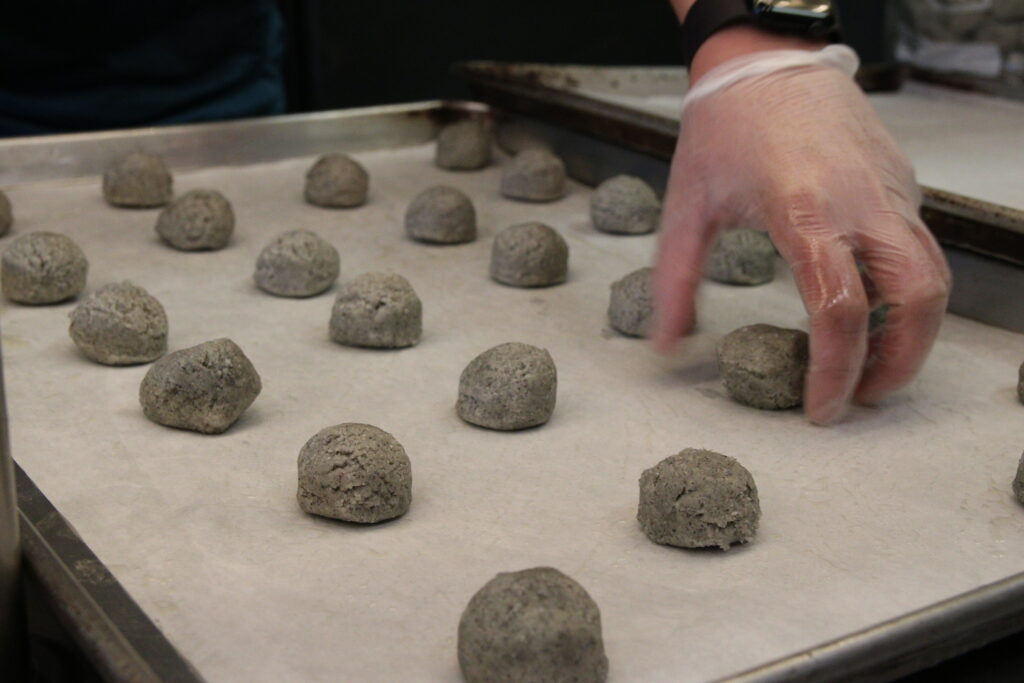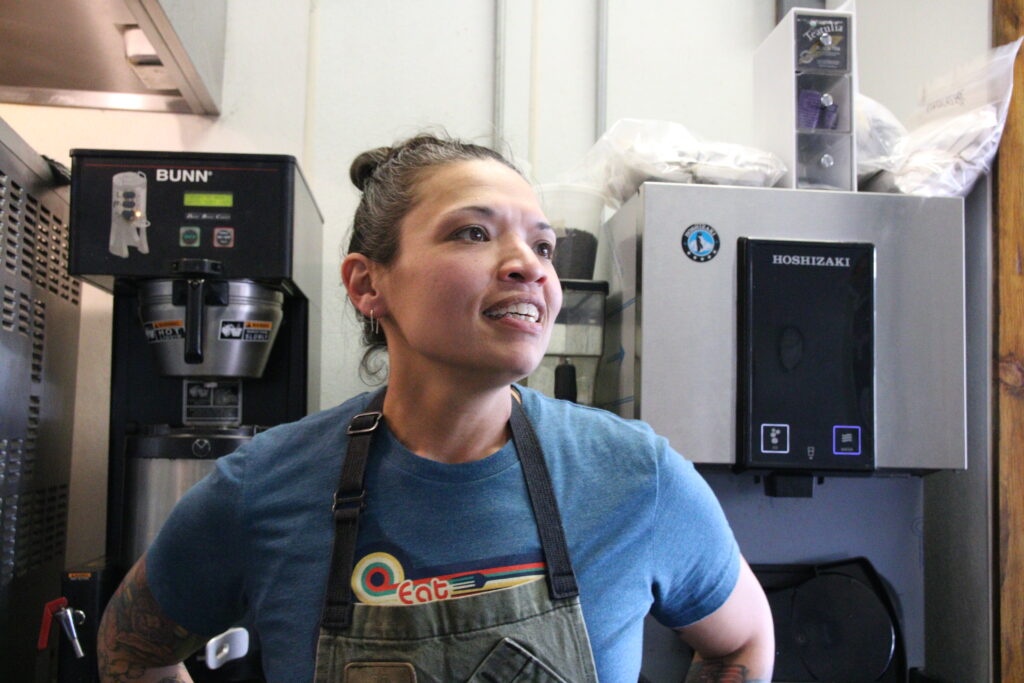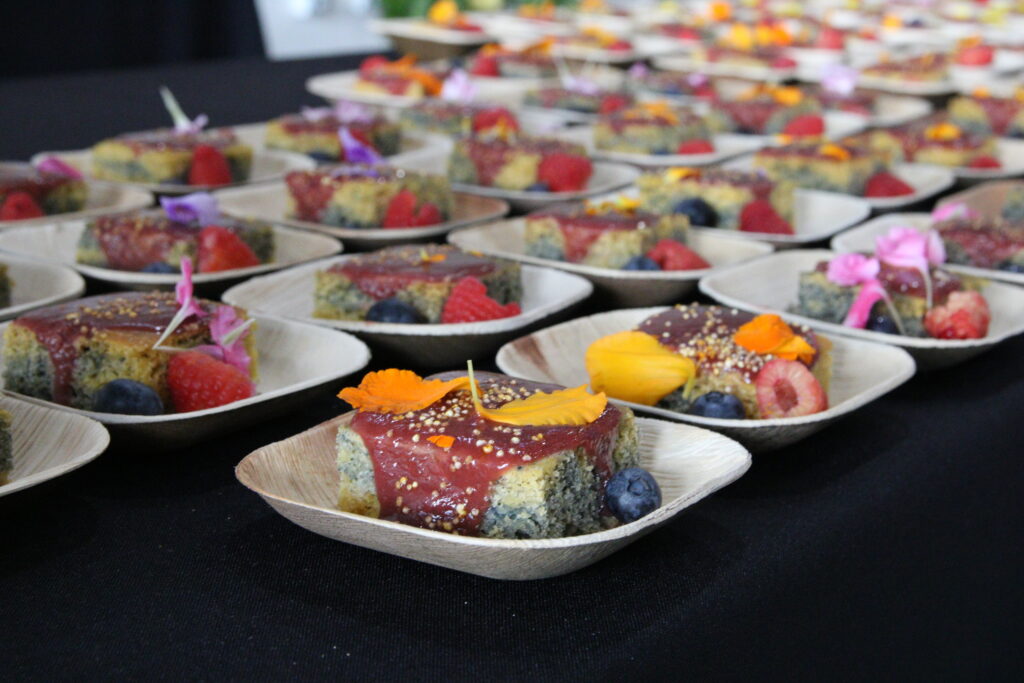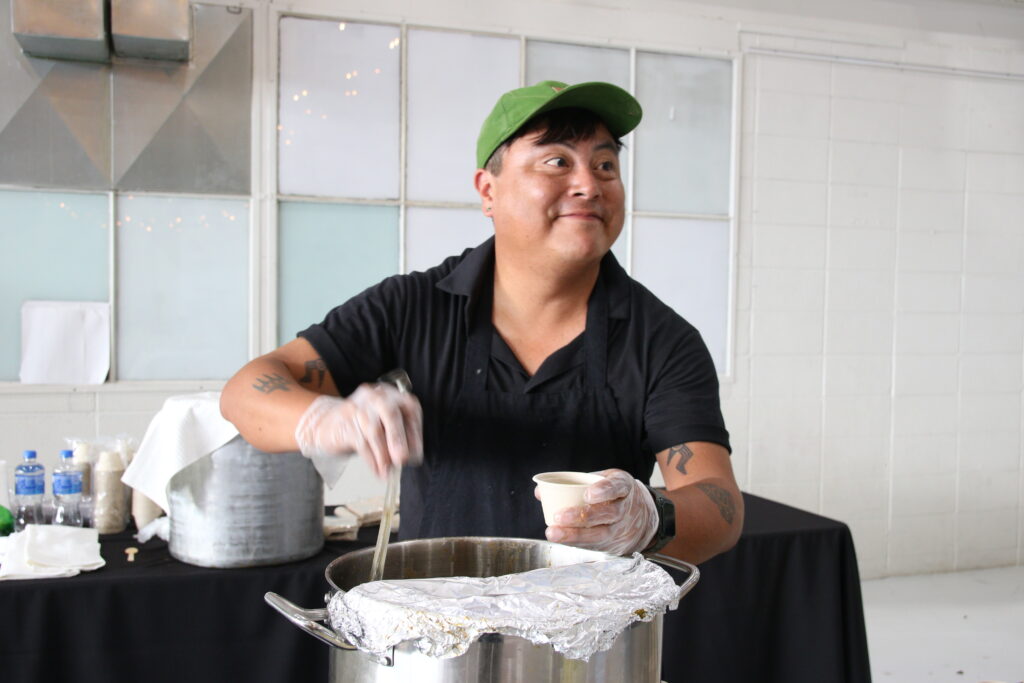How one chef is cooking up curiosity about Indigenous cuisine and causes
Emma VandenEinde
KUNC

Emma VandenEinde / KUNC Andean Chef Andrea Murdoch stands in front of her Ute Mountain Ute Blue Cornmeal Swirl cake at the Denver EATSS event at Stanley Marketplace in Aurora, Colo., on June 14, 2023. She’s one of the five Indigenous chefs that were picked to share a meal with guests.
Chef Andrea Murdoch is busy in the kitchen of the Same Café in Denver — a pay-what-you-can restaurant run entirely by volunteers. She commonly uses the kitchen space when she needs an extra oven or two.
“Everything is a combination of Russian roulette and a Rubik’s cube in kitchens,” she said to a volunteer chef, laughing.
As volunteers take out pans and rip off pieces of parchment paper to cover them, a sweet smell wafts from the ovens. Murdoch is baking her famous light blue sugar cookies for an Indigenous Comic-Con event later that week.
“They look good, and they smell good, too!” said one volunteer chef.
“And it supports Indigenous economies!” Murdoch yelled back.

But Murdoch — one of the Indigenous chefs that’s part of a new wave of Indigenous cuisine in Colorado and other parts of the Mountain West — doesn’t make cookies like other chefs. Instead of using flour, she’s utilizing Ute Mountain Ute cornmeal found in Southwest Colorado.
“Blue cornmeal is something that’s very specific to the Four Corners region of the U.S.,” she said. “You will not find this easily out on the West Coast, out on the East Coast.”
And this isn’t the first time she’s used unique ingredients in her cooking to support and highlight Indigenous food sources.
“I sourced locally and Indigenously to support those economies,” she said. “Kroger doesn’t need my money.”
Going back to her origins
Murdoch’s story is quite the journey, born out of the connection to her culture. She was born an orphan in Caracas, Venezuela, near the Andes Mountains. She was adopted shortly after and came to the United States. She grew up cooking with her family and soon went to culinary school in New York.
Despite the various places she cooked and traveled, she has always been impacted by the women of Oneida Nation — only a few hours from Milwaukee. They shared their creation story with her as well as how to make their version of cornbread.
“It unlocked something in me where I just felt at home,” Murdoch said. “…Having that kind of cultural experience and mindset, that felt like a reconnection.”

Soon after, Murdoch wanted to expand Four Directions Cuisine — her food business — and create South American cuisine. Through her research, the Andinan chef found the ingredients that were representative of the culture were pre-colonial. That refers to any food that existed in America before colonizers arrived, like rabbit or bison.
“I was tapping in more and more to my ancestry, whether I knew it or not,” Murdoch said.
She wanted to “go back to her origins” in her cooking and support Indigenous communities. Her ingredients come from Indigenous or local farmers, like Miller Farms and Strohauer Farms. She chooses ingredients within the state as much as possible and does what her ancestors did — live off the land.
“[I] utilize what is there,” she said. “We didn’t have this, ‘Oh yeah, just ship it from wherever you are.’”
She also taught herself how to forage on her own for ingredients. She shared how she will take her dog and go out by herself as her “quiet time”, looking for flowers or spruce tips for her dishes.
“I especially love it when it’s raining and I’m out there foraging because I’ll talk specifically to Illapa, our weather god, because that rain is a gift that is going to help our crops,” she said. “It’s going to help the land, it helps all the things. It’s part of the system that makes everything go round.”
She will frequently talk to the gods and her ancestors while she cooks. Murdoch lays out all the ingredients in front of her and just starts cooking, tapping into what she calls her “sixth sense.”
“I don’t always approach cooking and creating menus the way most chefs approach it,” she said. “There’s an element of listening to the ingredients and understanding how you’re going to honor them best.”
While she doesn’t own a brick-and-mortar restaurant yet, she cooks for various events through Four Directions Cuisine — anything from a mirco-wedding, to cooking classes to a small chef’s table. She loves serving smaller groups because there’s more room for “whimsy.”
“[I’ll] say, ‘Hey, if it’s OK with everybody, I have these pickled spruce tips that I think go really, really nicely on top of your elk meat taco,” she said. “And everybody just kind of looks around like, ‘Yeah, we’re game.’ And then that becomes a garnish and it also becomes a conversation piece and I get to talk to them about how I went foraging [and how] the buds are only out there for a limited time before they do fully sprout.”
Murdoch said it’s rewarding to watch Indigenous people reconnect to their ancestral foods — as well as watching people try new ingredients for the first time.

“To see that satisfaction on their face, I’m just like, ‘Yes, yes,’” she said. “That’s what knowledge exchange and cultural exchange in particular is all about.”
She hopes those who eat her food take away the deeper knowledge of where it comes from and its ties to culture.
“The way I look at food is respect,” she said. “It goes back to the Indigenous culture that plants aren’t just plants, they are plant relatives.”
Native cuisine: becoming popular, yet still hidden
This type of Indigenous cooking has grown in popularity, with many restaurants opening since the pandemic in big cities such as Minneapolis and Seattle. Some Indigenous chefs are also expanding in the world of cookbooks. And, for the second year in a row, an Indigenous chef won a James Beard award. The James Beard is almost like the Oscars for cooking.
Murdoch said Indigenous creatives like these have always existed, but they were in limited spaces. She’s excited to finally see their work in the spotlight.
“If you had told me five years ago that this is what the Indigenous food landscape was going to look like in this country, that we were going to have more restaurants being open, that people were going to say yes and greenlight Indigenous-based projects, I probably would have looked at you with so much skepticism,” she said.
But it wasn’t always this way, and in some cases, it is still invisible to the public. Many people can’t name even one Native restaurant, and Google often lumps the restaurant category “Native American” with “Indian” or other ethnic restaurants.
“Even pho, Thai cuisine, like, I can find those restaurants a hundredfold before I find an Indigenous cuisine-based restaurant,” Murdoch said. “And we live on the continent of North America.”
Many other Indigenous chefs feel this way. Sean Sherman, the head chef of Owamni in Minnesota and winner of multiple James Beard awards, said many people draw a big question mark when it comes to identifying Indigenous dishes.
“We should really be focused on what’s the true food of North America,” he said. “And you can’t understand North American food unless you bring the Indigenous perspective into it.”
He spoke in a TEDTalk about how the absence of Native restaurants has to do with history. Bison were killed at alarming rates. Indian boarding schools and forced assimilation stripped them of their culture. And pushing Indigenous people onto resource-poor reservations without any land rights put them in a systemic trap.
“We just went through a really traumatic time in history where we haven’t had time to heal yet, let alone evolve,” he said. “… The more you dig into it, the more inequality you see and the more racist structures that you can see that are still built into the system.”
Sherman is hopeful about the Indigenous food producers, chefs and food trucks that are coming onto the scene, but he said there’s room for more — as well as more room for understanding.
“There’s just a lot of work to do and there’s a lot of minds to change. But we’re doing it through something very positive, which is food.”
That’s exactly what Murdoch wants to highlight. The work she does for Four Directions Cuisine is not just catering — she’s hosted fundraising dinners to bring awareness to Missing and Murdered Indigenous Relatives, with proceeds going to the National Indigenous Women’s Resource Center. She also wrote a book on Indian boarding school trauma, with a percentage of the sales going to the National Native American Boarding School Healing Coalition.
“Yes, I’m a chef, but I’m using that platform to bring awareness to cultural issues,” she said.
Feeding beyond food
One recent event Murdoch helped with was Denver EATSS, or the Epicurean Award To Support Scholars event, in June. Hosted by the American Indian College Fund, it raises tens of millions of dollars each year for students to attend one of the 35 tribal colleges and universities in the nation, including schools in Arizona and New Mexico in the Mountain West.
“Having access to college experience is a universal challenge, but it’s more so I think, in Indigenous communities where there’s a lot less access to economic resources, there’s a lot less physical access to places to go to college,” said Cheryl Crazy Bull, a Sicangu Lakota and Rosebud Sioux woman, and the College Fund’s CEO. “We find if we remove those barriers, then we increase Native student participation.”
The dinner portion of the event sheds light on some common foods that were pre-colonial and how Indigenous people have used these foods for centuries.
The Indigenous chefs prepared a variety of dishes. Murdoch made a swirl cake using ingredients like popped amaranth, strawberry sauce, edible flowers and the same cornmeal from her sugar cookies. Chef Bradley Dry of the Cherokee Nation in Oklahoma made a Hen of the Woods Mushroom soup with roasted blue cornmeal and onions.

“[It’s] my homage to my family, because … I grew up foraging mushrooms with my family,” Dry said. “This is kind of a mixture of everything I ate as a kid in a soup form.”
The main food for the event was catered by Tocabe American Indian Eatery in Denver. Ben Jacobs, the eatery’s co-founder and a member of the Osage Nation, did variations on traditional dishes, like blue corn mush, Osage Hominy relish, and Three Sisters.
“We call that a ‘Three Sisters, One Bite’ because all three sisters — corn, beans and squash — are all in one bite,” he said, pointing to the dish on the table. “We have a blue corn chip, white bean purée, butternut squash, New Mexican red chili, amaranth, microgreens, smoke, and salt.”
Jacobs shared how his love for cooking was inspired by his parents who opened up a small Native restaurant in Denver in 1989 for the Indigenous community. About 20 years later, Jacobs and his co-founding partner, Matt Chandra, opened Tocabe’s first location. His goal with the restaurant was to make Native cuisine accessible and show others what Native people contribute to the culinary scene.
“[We] wanted to create something that wasn’t just always for a community event,” he said. “We wanted to create that for our people, for our community, but also as a way to share identity and culture and who we are and where we’re going.”
Since then, one of Tocabe’s brick-and-mortar locations has shut down and reconverted into a Native ingredient fulfillment center that plans to distribute meals to tribal communities. Jacobs said since the beginning, his work has always been about supporting the community — not a profit margin.
Story and photos by Emma VandenEinde, Mountain West News Bureau and KUNC reporter
This story was produced by the Mountain West News Bureau, a collaboration between Wyoming Public Media, Nevada Public Radio, Boise State Public Radio in Idaho, KUNR in Nevada, KUNC in Colorado and KANW in New Mexico, with support from affiliate stations across the region. Funding for the Mountain West News Bureau is provided in part by the Corporation for Public Broadcasting.
This story is republished via AP StoryShare.






